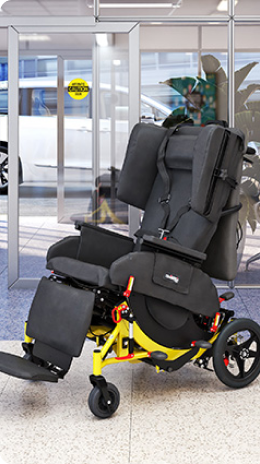The Need for Caregiver Safety
Health care occupations suffer the highest rates of musculoskeletal injuries from overexertion among all industries in the United States.1 Despite caregiver safety programs, hospital workers suffer more injuries than the national workforce average by a factor of two. In truth, nursing home workers are even more at-risk, with over three times the average rate of overexertion injuries.2 The largest contributing factor to these injuries is manual patient handling.1
Moving, lifting, and repositioning a patient requires substantial effort from caregivers. This is true even with standard medical equipment like belts or lifts. Often, staff are overwhelmed with many patients in their charge. As a result, they feel pressured to rush through lifts and transfers. Although safety is difficult to achieve, a Broda wheelchair can help.
How to Achieve Safer Patient Handling
A positioning wheelchair from Broda has safety features to reduce caregiver injury and save time. For example, many of our positioning wheelchairs feature 90 degrees of recline and removable arm and shoulder supports. As a result, caregivers can use a slide board to transfer the user directly from their bed to their wheelchair, no lifting required. In addition, the Broda tilt and recline features are operated by special cylinders that make it easy to raise and lower the wheelchair user. In conclusion, Broda wheelchairs can contribute to improving a safe patient handling program.
Caregiver Safety & Convenience
If a wheelchair doesn’t fit properly, then the patient safety risks increase substantially. Some wheelchairs are difficult to adjust. Many can only be adjusted with a full set of tools by a qualified Assistive Technology Professional (ATP). On the other hand, Broda wheelchairs have easy, built-in adjustments. Surprisingly for many, you can make these adjustments without tools! With Broda, you can quickly and easily create a safer, custom fit for each patient.
Caregiver safety is an important area of focus for all care environments. If you are ready to reduce employee injuries and simplify patient care, then contact us to schedule a demonstration today.
References:
1. Centers for Disease Control and Prevention. (2013, August 2). Safe patient handling and mobility (SPHM). Centers for Disease Control and Prevention. Retrieved February 22, 2022, from https://www.cdc.gov/niosh/topics/safepatient/default.html
2. Bureau of Labor Statistics. (2014). Table R8. Incidence rates for nonfatal occupational injuries and illnesses involving days away from work2 per 10,000 full-time workers by industry and selected events or exposures leading to injury or illness, private industry. Bureau of Labor Statistics. Retrieved February 22, 2022, from https://www.bls.gov/iif/oshwc/osh/case/ostb4374.pdf

